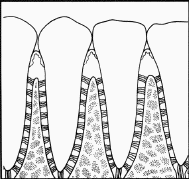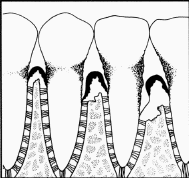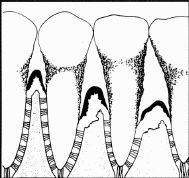|
Gingivitis
is a gum condition that results from our own body's attempt to kill the bacteria that is naturally present in our mouths. These bacteria
secrete waste products as they grow and multiply. The waste products are not only sticky,
inviting even more debris to attach to it, but also suppressive in so far as inhibiting healthy
tissues from regenerating.
The sticky substance is called plaque, which can be found above and below the
gumline.
This plaque can harden over a period of time and turn into tartar. Tartar harbors
even more
bacteria and waste products, thus accelerating the breakdown of the gum tissue.
Bad
breath can even result from such a build up of bacteria.
Periodontal
disease is the next phase of this condition, which leads to
severe breakdown of the gums and destruction of the supportive jaw bones.
|

|
This is what healthy
gums should look like. The gums are pink
in color,
with a dull orange-peel like surface. They are resilient and do not bleed. |
| |
|
| If you have a dark complection, your
healthy gums may look like this: |

|
| |
|
|

|
The first signs of gingivitis
is depicted in this photo. The gums lose their pink dull appearance
and develop a red
shiny look. The plaque is often
invisible at this stage. |
| |
|
This is the perfect photo that depicts gingivitis with the
associated tartar that is so often
the culprit of this condition, which can easily lead to periodontal
disease. |

|
I would be more than happy to answer
any other questions that you might have concerning your teeth and today's dentistry.
Gum disease (also called
periodontal disease) is an infection of the tissues surrounding and
supporting the teeth. It is a major cause of tooth loss in adults. In
fact, after age 35, about 3 out of 4 adults are affected by some
form of gum disease.
Gum disease is caused by plaque, a sticky film of bacteria
that constantly forms on the teeth. These bacteria create toxins that can damage
the gums. In the early stage of gum disease, called gingivitis, the gums can
become red, swollen and bleed easily. At this stage, the disease is still
reversible and can usually be eliminated by daily brushing and flossing.
Because gum disease is usually painless, however, you may
not know you have it. In the more advanced stages of gum disease, called
periodontitis, the gums and bone that support the teeth can become seriously
damaged. The teeth can become loose, fall out or have to be removed by a
dentist.
If you notice any of the following signs of gum disease,
see your dentist immediately:
- gums that bleed when you brush your teeth
- red, swollen or tender gums
- gums that have pulled away from the teeth
- bad breath that doesn't go away
- pus between your teeth and gums
- loose teeth
- a change in the way your teeth fit together when you
bite
- a change in the fit of partial dentures
 |
Normal, healthy gums
Healthy gums and bone anchor teeth firmly in place. |
 |
Periodontitis
Unremoved, plaque hardens into calculus (tartar). As plaque and
calculus continue to build up, the gums begin to recede (pull away) from
the teeth, and pockets form between the teeth and gums. |
 |
Advanced periodontitis
The gums recede farther, destroying more bone and the periodontal
ligament. Teeth — even healthy teeth — may become loose and need to
be extracted. |
The good news is that you can help prevent gum disease by
taking good care of your teeth every day and having regular dental checkups.
Here's how to keep your teeth and gums healthy:
- Brush your teeth well twice a day.
This removes the film of bacteria from the teeth. Be sure to use a
soft-bristled toothbrush that is in good condition. Toothpastes and mouth
rinses containing fluoride strengthen the teeth and help prevent decay.
Choose products that bear the American Dental Association Seal of
Acceptance, a symbol of a product's safety and effectiveness. The ADA
reviews all advertising claims for any product bearing the Seal. The Seal on
a product is an assurance for consumers and dentists against misleading or
untrue statements concerning a product and its use, safety and
effectiveness.
- Clean between your teeth every day.
Cleaning between your teeth with floss or interdental cleaners removes
bacteria and food particles from between the teeth, where a toothbrush can't
reach. Early gum disease can often be reversed by daily brushing and
flossing. If you use interdental cleaners, ask your dentist how to use them
properly, to avoid injuring your gums.
- Eat a balanced diet.
Choose a variety of foods from the basic food groups, such as breads,
cereals and other grain products; fruits; vegetables; meat, poultry and
fish; and dairy products, such as milk, cheese and yogurt. Limit
between-meal snacks.
- Visit your dentist regularly.
It is important to have regular dental checkups, and professional cleaning
is essential to prevent periodontal diseases.
for more detail how how to control your oral hygiene
click here
|
![]()